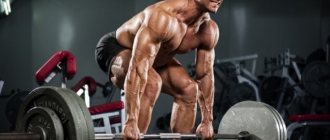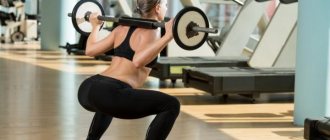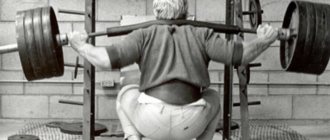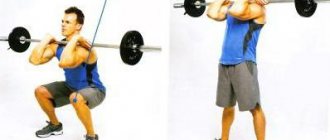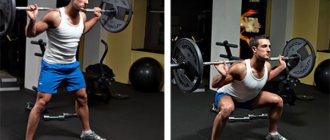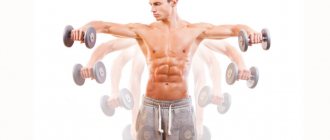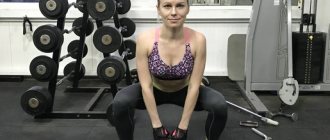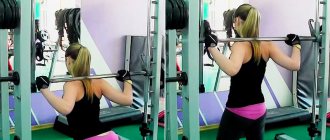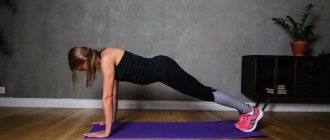Share:
What you need
- Barbell
Squats with a barbell on your shoulders are a basic exercise common in CrossFit and powerlifting, involving a huge number of muscle groups. Along with the deadlift and bench press, it is a kind of indicator of the athlete's functional and strength training, and the correct technique for performing this exercise is critically important. Today we will tell you how to do a barbell squat correctly, how to increase your results and what you can replace this exercise with.
The barbell squat is an integral tool for developing muscle mass in the legs and buttocks; there is hardly a single athlete in the world who does not do squats, and at the same time boasts powerful quadriceps. For this reason, this exercise has gained immense popularity in every gym in the world, and making progress in the squat is a significant goal for many experienced and not so experienced athletes.
Today we will tell you about how to do squats with a barbell correctly - the technique of the exercise, as well as what muscles work, all the pros, cons and contraindications to heavy squats. And a lot of other useful information.
Why is this exercise needed?
Legs are our foundation, no matter what sport we play. Boxing, wrestling, crossfit, powerlifting, fitness - you will not achieve significant success in any of these disciplines if your legs do not receive sufficient load as part of your training process.
The barbell squat is perhaps the heaviest exercise of all. And not only physically, but also mentally. Watch any powerlifting competition and notice how the lifters prepare themselves before their squat attempts. It is unlikely that you will want to get in the way of this person. Only in a state of crazy courage can you conquer such inhuman weights.
We’ve sorted out powerlifting, where the squat is a competitive movement. What is the role of squats in CrossFit:
- Squats with a barbell on the shoulders are part of many complexes for athletes of different levels of training.
- Without a technically correct squat, you can forget about movements such as the snatch, clean and jerk, thrusters, cleans, etc.
- The squat is one of those exercises that ramps up the intensity and pace of your workout. Performing really heavy squats requires enormous energy expenditure, emotional state and motivation, significantly increasing the heart rate, which contributes to the process of lipolysis.
Lesson program
Many people believe that it is enough to take a ready-made squat scheme without a barbell and follow it, but with a projectile. This opinion is critically erroneous, since in such programs, as a rule, a large number of repetitions is indicated in each approach. When working with weights, the main thing is not quantity, but quality. Therefore, there are fewer squats, but the efficiency is many times greater. Here is a good scheme that will suit both men and women:
- Day 1. 2 sets of 5 squats with a barbell on the shoulders;
- Day 2. Rest.
- Day 3. 2 sets of 5 squats with a barbell on the shoulders, 1 set of front squats;
- Day 4. Rest.
- Day 5. 2 sets of 7 squats, barbell on shoulders; 2 sets of 7 times, barbell on the sternum;
- Day 6-7. Rest.
In the second week, we listen to our feelings. If it’s hard, repeat the previous scheme. If everything is OK, add 3-5 repetitions in each approach.
In the third week, you can connect several approaches in other variations of squats (narrow, wide, lunges, etc.), depending on the goal being pursued.
In the fourth and further weeks, when the number of repetitions increases to 10-12, and approaches to 4-6, you can begin to increase the weight.
Now let's talk about how to replace barbell squats.
What muscles work?
The main dynamic load falls on:
- Quadriceps;
- Biceps femoris;
- Adductor muscles of the thigh;
- Gluteal muscles;
- Spinal extensors.
The abdominal muscles, gastrocnemius, soleus and trapezius muscles act as stabilizer muscles throughout the movement.
Why squat below parallel?
Before analyzing the exercise technique, let's clarify why you need to do deep squats. Do they have any advantages over classic barbell squats? Or maybe they do more harm?
Let's start with how full squats differ from regular squats, namely the depth of the squat. When performing the exercise, the pelvis drops almost to the floor. This mechanics increases the range of motion, which means the muscles work more intensely. The deep or full squat is a powerful exercise for developing leg mass and strength. The quadriceps receive the maximum load, the buttock muscles also work, the back of the thighs and calf muscles are activated. In addition to affecting the muscles, the exercise develops explosive strength and endurance well.
Who needs to do these squats and why:
- Athletes involved in weightlifting. Everything is clear here; deep squats with a barbell are traditionally included in their training program and are a necessary element for mastering.
- For powerlifters to increase performance in strength exercises. Despite the fact that deep squats are not a competitive element in powerlifting, their periodic inclusion in a training program can give a good impetus to muscle development.
- Bodybuilders can perform this exercise to gain muscle mass in their quadriceps.
Depending on the specific goal, each athlete chooses the weight and number of repetitions.
You can often hear that deep squats are recommended for girls who want to pump up their buttock muscles and improve the shape of their legs. This statement is generally true, but there is one thing.
Yes, of course, the lower we squat, the better the gluteal muscles stretch and the more work they do. That is, according to this indicator, deep squats are much more effective than regular ones. But it should also be said that the main load in this exercise is still taken by the quadriceps. That is, mostly the front surface of the thigh sways, and secondarily the muscles of the buttocks. And for many girls, it is critically important that their buttocks be large and round, but their legs do not look over-pumped.
Therefore, the inclusion of such squats in training programs for girls should be treated wisely. If you need to target your butt muscles, try glute bridges, wide lunges, hip thrusts, and other exercises.
Pros and cons of barbell squats
The barbell squat is a basic compound exercise that works almost every major muscle group in your body. It is unlikely that any exercise other than the deadlift can compare with squats in this regard. This kind of load cannot but lead to results: you become stronger, more resilient and more muscular.
Benefits of exercise
For men, heavy squats are the #1 exercise. Numerous studies prove the hypothesis that performing this exercise leads to increased secretion of the main anabolic hormone - testosterone. It is this hormone that is responsible for all the traits inherent in a real man: physical strength and endurance, self-confidence, consistently high sexual energy, cheerful well-being, as well as what is commonly called “male charisma.” For this reason, we recommend that all men, regardless of age, perform barbell squats, unless there are medical contraindications.
Start with small working weights and gradually add discs to the barbell, then over time you will see that you have not only made serious progress in your workouts in the gym, but also generally feel more confident and energetic.
However, all this does not mean that squats are a purely masculine exercise. For girls, barbell squats should also become one of the foundations of the training process. It is this movement that puts the most stress on the hips and glutes and gives them an athletic shape.
In addition, intensive squats involve a fairly serious expenditure of energy. A few really hard sets will burn more calories than walking on a treadmill for half an hour. Therefore, squats should be performed not only if your goal is to slightly pump up your legs and buttocks, but also during the period of getting rid of excess fat, so the drying process will be much more efficient.
Possible harm from exercise
All potential harm from barbell squats comes down to the consequences caused by poor technique. A strong deviation from the correct technique or working with critically heavy weights can lead to injuries to the knee ligaments and joints, as well as the occurrence of protrusions and hernias in the lumbar spine. Injuries to the shoulder joints and rotator cuff are also not uncommon. As a rule, they arise as a result of incorrect (too low) position of the barbell.
It is also believed that barbell squats lead to one unpleasant side effect - an increase in waist size. This is not entirely true, because your waist size is determined by genetics, the tendency of the obliques to hypertrophy, and the volume of your stomach. However, the load on the obliques and abs during squats is really serious, and if you value your waist and feel that it is starting to grow, then it is better to slow down with heavy weights in squats and deadlifts. Squats also increase intra-abdominal pressure, which can lead to the formation of an umbilical hernia, but in most cases this problem can be avoided by using an athletic belt.
Contraindications
During squats with a barbell, a strong axial load is created on the spine, so this exercise is strictly contraindicated for all athletes who have any problems with the musculoskeletal system. The same goes for knee or hip joints: if you have had injuries in the recent past, then performing barbell squats should be kept to a minimum. For rehabilitation and restoration of injured tissues, it is better to use isolated exercises, for example, bending and extending the legs in a machine.
What are the benefits of squats?
From this article you can learn about the benefits of squats, contraindications and how to do it correctly to achieve excellent results.
Benefits of squats
- Muscles work. When you squat, most of the muscles in your lower body are activated. The abdominal and back muscles also become a little tense.
- Blood circulation improves. If you squat regularly, the work of blood vessels in the pelvic area is stimulated. As a result of this, metabolism improves, which has a positive effect on the general condition of a person. It also benefits women's health, and the skin becomes more toned.
- The figure is being corrected. In principle, this is the main reason why girls start squatting and do it right. The body becomes more toned, posture is leveled, fat on the sides, legs and abdomen disappears. It is also a very effective remedy for combating cellulite.
- General physical condition improves. Thanks to squats, leg muscles and tendons are strengthened, which means a person becomes more resilient, which is important for the immune system.
- You lose extra calories, which means you lose weight. Especially if you squat intensely or with additional weight.
Contraindications
Even the most useful thing is not suitable for everyone. The same principle applies to squats.
So, if you have injured joints and leg bones or other bone diseases, hypertension, varicose veins, scoliosis or hernias, then it is better to avoid squats so as not to aggravate the situation. In case of diseases of the cardiovascular system, it is important to consult with your doctor, and he will set your norm, which will not harm you.
Squatting correctly
It is very important to squat correctly. Otherwise there will be absolutely no effect. Not only that, you may even damage your back, joints or tendons.
- The back should be straight. So that you can draw a straight line from the back of your head to your tailbone. Be careful not to sway from side to side. Perform each exercise carefully and slowly.
- The abdominal muscles need to be tightened a little to fix the spine. This is especially important if you are going to squat with additional weight.
- Stretch and warm up before exercise. If you have a whole complex there, then squat somewhere in the middle of the process.
- We place our feet shoulder width apart. Try not to let your knees protrude further than your toes.
- We do not lift our feet off the floor so that the main load falls on the middle of the foot.
- Regular squats can be done to failure, but with weights no more than 35 squats, dividing them into several approaches.
- If you suddenly feel pain in your legs, joints or back while doing squats, it is better to stop and consult a doctor.
Well, it would seem like such a simple exercise, but so many aspects need to be taken into account. But believe me, it's worth it. Do everything right and the result will not be long in coming.
Execution technique
There are many hypotheses regarding the correct technique for squats with a barbell on the shoulders. Their number is due to the fact that the technique can vary due to the anatomical characteristics of a particular person (for example, the length of the limbs, the volume of the buttocks, flexibility in the hip and shoulder joints, etc.). Therefore, the recommendations listed below are of a general nature only; a competent personal trainer can help you develop a more acceptable technique. Well, let's figure out how to do a barbell squat correctly.
Taking the barbell on your back
The first phase of the movement is to remove the barbell from the racks. Grasping the bar tightly at a width slightly wider than your shoulders, we sit under the bar exactly in the center of the bar, pressing into the bar with our trapezoids, and remove the bar with the movement of our legs. It is extremely important to keep your back straight when removing the bar from the racks, since it is at this moment that our spine experiences maximum axial load.
The next phase is to move away from the posts and secure yourself. You need to take a few steps backwards, find a stable, stable position and begin the exercise. Take your time when you step backwards; your movements should be smooth and confident. Otherwise, you will lose balance and control of movement, thereby risking injury.
Squat
Safety precautions
Very soon we will begin to explain how to do squats with a barbell on hands, but first we need to talk about safety precautions. We hope there is no need to explain why this is necessary.
- Never exercise when you feel unwell, under the influence of alcohol or other intoxication, or if you feel acute pain in your muscles or ligaments;
- Always do a warm-up - squats with an apparatus on cold muscles - suicide for the latter;
- Work smoothly, without jerks or jolts;
- When squatting, do not lift your head up; you may lose your balance. Don't look down either. Ideally, look at yourself in the mirror, keeping your head and eyes straight;
- Exercise with equipment: elastic bandages, athletic belt, wristband, hard-soled shoes, comfortable clothes.
- When squatting with super-heavy weights, be sure to involve a partner as a backup. Or better yet, 2 or 3. Don’t hesitate to ask people in the gym for help if you come to study alone. Sports etiquette will not allow them to refuse you;
- Start with light weights and gradually add pancakes;
- Don't do too many repetitions (more than 6) as the axial load is too taxing on your back. The number of repetitions in one approach is 6-12.
As you can see, there are not very many rules and they are all adequate.
How to increase your barbell squat?
Every second gym goer wonders how to increase a barbell squat. There are many methods, but the point is always in two aspects: proper cycling of loads (using percentages and alternating light/heavy training) and performing auxiliary exercises. In practice, a competitive powerlifter will typically do two squat workouts per week, one with a weight equal to 50-60% of the maximum for 5 reps for three sets, and the other with a weight equal to 75-85% of the maximum. maximum, 5 repetitions in five approaches. Closer to the competition, the weight of the bar increases, and the number of repetitions decreases.
When it comes to accessory exercises, the most commonly preferred exercises are pause squats, front squats, barbell bend-overs, bench squats, and overhead squats.
- Pause squats are a type of squat in which the athlete works at the deepest possible amplitude, fixating for a few seconds at the lowest point. The upward movement is explosive in nature, thereby significantly increasing the speed of the lift during normal squats.
- Front squats differ from classic squats with a barbell in the position of the bar - here it is on the chest. Thanks to this, the vector of movement changes slightly, and the quadriceps receives a more serious load.
- Bent-overs are extremely important for strength athletes because they help keep your core more stable during heavy squats.
- Bench squats are a type of squats with a shorter amplitude (we lower ourselves above parallel), where our task is to lower ourselves to the level of the bench.
- Overhead squats are a coordination exercise that are quite challenging for beginners. Helps you get a better feel for corners and blind spots.
Three popular squat variations
Back squats are the best leg exercise, but they are far from the only one.
Let's look at three variations that are worth knowing and that can be used instead of or in addition to the classic version with a barbell on the back:
- Frontal.
- Bulgarian split.
- Goblet squats.
Front Squats
From the waist to the feet, they are no different from the classic ones. The key difference is that the barbell is held on the shoulders rather than on the back.
This is what it looks like:
The main advantage of front squats is that they place even more emphasis on the quadriceps and upper back and allow you to squat deeper than with the classic low bar position. In addition, they reduce the load on the knees and lower back, which makes them ideal for people who have any problems with the joints.
The disadvantage is that you cannot use heavy enough weights and this exercise is very awkward to perform.
It requires quite a bit of wrist mobility to do it correctly, so some people cross their arms like this:
This grip is more comfortable, but, unfortunately, less stable and is not suitable for working with heavy weights. This is why a traditional front squat grip is recommended, even if you can only grip the bar with one or two fingers.
Bulgarian split squats
They are quickly becoming more and more popular among coaches of speed and strength sports. And there is good reason for this.
Research shows that it allows you to add weight to classic squats with little stress on your lower back. Unlike the front ones, it puts more load on the back of the thigh. Evenly distributes the load on each leg (when squats with a barbell, the muscles often develop asymmetrically - one leg is stronger than the other). Ideal for training at home.
This is what it looks like:
They are auxiliary because it is impossible to use significant weight in them.
Goblet squats
Very similar to fronts, except that you use a dumbbell instead of a barbell.
This is what it looks like:
As the name suggests, you hold the dumbbell close to your chest (don't let it go forward) as if it were a large goblet, but otherwise it's a regular squat.
The main advantage, as with all dumbbell exercises, is convenience - you don't need a barbell. Therefore, this option is very popular at home.
This is also a good alternative to barbell exercises when you have shoulder or back pain.
Common mistakes
If doing squats doesn't give you the results you want, you're doing something wrong. Below is a short list of the most common mistakes that are common to most novice athletes:
Incorrect range of motion
Only deep squats give a truly serious effect. If you don't even go down to parallel level with the floor, then don't expect results. At the lowest point, the back of the thigh should touch the calf muscles. Not all athletes succeed in this immediately due to weak stretching, so do not forget to stretch after training, special attention should be paid to the quadriceps and adductor muscles of the thigh.
Rounding the back while lifting
This can be seen in every gym when an athlete squats with maximum weight. If your back is not strong enough to stay straight during heavy squats, then you should lower the weight a little and start training your spinal extensors. Hyperextensions with additional weights are best suited for this. Using an athletic belt also partially solves this problem.
Movement in the lumbosacral spine
You may have seen more than once how some athletes “peck” their tailbone at the lowest point of the amplitude. This makes lifting a little easier, but under no circumstances should you do this - this is a direct path to injury.
Movement in the knee joint
Throughout the entire exercise, your knees should be in the same plane as your feet. Movement of the knees inward relative to the proper trajectory is unacceptable. A meniscus injury can put an end to your sports career.
Incorrect foot position
The feet should be slightly turned out and slightly wider than shoulder level. This is the only way you can sit deep enough without creating a strong load on the knee joint.
Incorrect breathing technique
Remember one simple rule: exhalation is always done with effort. Therefore, you need to inhale while going down, exhale while going up. If you do not follow this technique, your muscles will not receive enough oxygen and the effectiveness of the exercise will be greatly reduced. Deterioration in health, headache, nausea and fainting are also possible as a result of insufficient cerebral blood supply and increased intracranial pressure.
Where to begin?
This time we’ll start from the end, I’ll explain why. I often observe beginners in the gym who come to class for the first time and try to squat with a barbell. They cannot squat normally even without additional weight, what can we say about squats with a barbell on their shoulders? Of course, in such cases the technique leaves much to be desired, and you cannot look at such a performance without tears.
It would seem that there is nothing easier than just squatting up and down without weights, but no, some people can’t even do that. It's all about the level of muscle flexibility. The incorrect technique looks something like this: look down, hunched back, as the body lowers down, the heels lift off the floor, the knees move inward, towards each other. I think it’s not worth even discussing what such a technique will lead to. Females, as a rule, fare much better with flexibility, but not everyone does.
A typical incorrect technique is depicted here:
What can be recommended for people with insufficient flexibility and poor technique?
First, do not try to squat with weight, that is, completely eliminate an exercise such as back squats. It will be much more useful to squat with a bodybar or wooden stick behind your back. The main thing is to learn to keep your shoulder blades retracted and not slouch in the thoracic spine. Correct fixation of the thoracic region is facilitated by the position of the head. In no case should the gaze be directed downwards - this will entail lowering of the head, and after it the thoracic region will lose fixation.
Secondly, you should work on the flexibility of the back of your thighs, calves and buttocks. This can be done perfectly at home, as well as squats with a stick behind your back. You need to remember that under no circumstances should you stretch in jerks; all movements must be smooth and controlled. Muscles stretch better when they are warmed up, so the best time to stretch would be after a workout or after taking a shower. You can easily find a complex for developing flexibility on the Internet. Remember that stretching should be done regularly, ideally daily.
Thirdly, you should not stop working out in the gym. If you don’t succeed with squats, then it’s okay, because there are many other exercises. Hyperextension is perfect for strengthening the lower back, all kinds of flexions can be done on the back of the thighs, and leg presses are suitable for the front of the thigh. At first, you should perform these exercises to strengthen your lower back and legs, at the same time practice flexibility and squat with a bodybar or stick behind your back. Over time, you can move on to back squats as your main exercise, but you need to start with an empty bar and develop technique with it.
Standards for squatting without equipment
Unfortunately, the federal budget of our country is not enough to promote the development of powerlifting, so we have only one federation officially accredited by the State Sports Committee of the Russian Federation - the Russian Powerlifting Federation (RFP).
The standard is assigned based on the sum of three movements (squats, bench press, deadlift). There is no separate test for squats. If you want to truly test your strength, I highly recommend taking part in competitions. Competitions are regularly held throughout the Russian Federation; the competition calendar and regulations can be found on the official website of the federation.
There are also more than ten non-state federations operating on a commercial basis. The main funding comes from private investors, advertising of thematic products (sports nutrition, clothing and equipment) and entry fees from competition participants. The most popular non-state federation is WPC/AWPC (without doping control/with doping control). Below are their raw powerlifting standards for 2021.
AWPC-Russia category standards for bare powerlifting for men:
| Weight category | Elite | MSMK | MS | KMS | I category | II category | III category | I junior | II junior |
| 52 | 490 | 432.5 | 377.5 | 340 | 302.5 | 265 | 227.5 | 187.5 | 150 |
| 56 | 532.5 | 470 | 410 | 367.5 | 327.5 | 287.5 | 245 | 205 | 162,5 |
| 60 | 570 | 505 | 440 | 395 | 350 | 307.5 | 262.5 | 220 | 175 |
| 67,5 | 635 | 562.5 | 490 | 440 | 392.5 | 342.5 | 292.5 | 245 | 195 |
| 75 | 692.5 | 612.5 | 532.5 | 480 | 425 | 372.5 | 320 | 265 | 212,5 |
| 82,5 | 737.5 | 652.5 | 567.5 | 510 | 455 | 397.5 | 340 | 285 | 227,5 |
| 90 | 777.5 | 687.5 | 597.5 | 537.5 | 477.5 | 417.5 | 357.5 | 297.5 | 240 |
| 100 | 817.5 | 725 | 630 | 567.5 | 502.5 | 440 | 377.5 | 315 | 252.5 |
| 110 | 852.5 | 752.5 | 655 | 590 | 525 | 457.5 | 392.5 | 327.5 | 262.5 |
| 125 | 890 | 787.5 | 685 | 617.5 | 547.5 | 480 | 410 | 342.5 | 275 |
| 140 | 920 | 812.5 | 707.5 | 635 | 565 | 495 | 425 | 352.5 | 282.5 |
| 140+ | 940 | 832.5 | 725 | 652.5 | 580 | 507.5 | 435 | 362.5 | 290 |
For women:
| Weight category | Elite | MSMK | MS | KMS | I category | II category | III category | I junior | II junior |
| 44 | 287.5 | 255 | 222.5 | 200 | 177.5 | 155 | 132.5 | 110 | 90 |
| 48 | 317.5 | 282.5 | 245 | 220 | 195 | 172.5 | 147.5 | 122.5 | 97,5 |
| 52 | 345 | 305 | 265 | 240 | 212.5 | 185 | 160 | 132.5 | 107,5 |
| 56 | 372.5 | 327.5 | 285 | 257.5 | 227.5 | 200 | 172.5 | 142.5 | 115 |
| 60 | 395 | 350 | 302.5 | 272.5 | 242.5 | 212.5 | 182.5 | 152.5 | 122.5 |
| 67,5 | 432.5 | 382.5 | 332.5 | 300 | 265 | 232.5 | 200 | 165 | 132.5 |
| 75 | 462.5 | 410 | 355 | 320 | 285 | 250 | 212.5 | 177.5 | 142.5 |
| 82,5 | 487.5 | 432.5 | 375 | 337.5 | 300 | 262.5 | 225 | 187.5 | 150 |
| 90 | 507.5 | 450 | 390 | 352.5 | 312.5 | 272.5 | 235 | 195 | 157,5 |
| 90+ | 520 | 460 | 400 | 360 | 320 | 280 | 240 | 200 | 160 |
What muscles are involved in the work?
The barbell squat is one of the main exercises that simultaneously activates several muscle groups. However, a large load still falls on the leg muscles. In addition, the muscles of the lumbar region and abdomen are worked out.
When squatting with a barbell correctly, the following actively work:
- quadriceps;
- buttock muscles;
- soleus muscles;
- biceps;
- calf muscles;
- abdominal muscles;
- back.
